How to save energy in a period home without ruining its character
Our experts tackle the historic homes versus energy efficiency debate, looking at how to make improvements to your home at different budgets, from £200 to £20k

If you’re living in a period cottage you may love the character but find fuel bills daunting. What can be done to reduce energy bills without damaging the building?
We put this challenge to a chartered building surveyor and historic buildings expert Marianne Suhr, and Paul Ciniglio, refurbishment lead for the National Energy Foundation. We also asked them to assume that the cottage has electric storage heating.
“The crucial thing is: what is the building made of?” begins Marianne Suhr, the co-author of Old House Eco Handbook. “If it’s an historic timber frame with very thin walls and lots of gaps then you need specialist advice as anything you do to that building could affect the moisture content of the frame and cause damage.
“It’s also important to make sure your building is dry, as heat loss is far quicker through a damp wall than through a dry wall.”
Thankfully, there’s plenty that can be done to make a period cottage warmer and more energy efficient as well as other energy saving tips.
How to save energy in a period cottage with only £200
For a modest £200, start by sealing up any obvious gaps where the draughts are causing heat loss including fireplaces, external doors and windows, says Marianne Suhr. Draught proofing in this way will improve both comfort levels and reduce heating bills — around 15% of heat loss is via draughts.
“In terms of draughty cottage doors, a thick thermally lined curtain that fits tight against the wall from floor to ceiling is a good way to help retain the heat — you could take the curtains away in the warmer months,” begins Marianne.
“Old fireplaces, especially inglenooks, can be a major source of heat loss via the open flue. Use a chimney balloon [such as this one from Amazon] to seal off the flu when the fire is not in use, but don’t forget to take it out when you light the fire.
“Cold floors such as stone flags can act as a heat sink especially if they are laid over concrete floor slabs. They will take on the ambient temperature of the room so it may be worth thinking about laying rugs over them to make it more comfortable to walk on.
“Carry out these DIY tasks well and you could be saving £200 a year.”

How to save energy with a £2,000 budget
If you have £2,000, Marianne recommends carrying out all the suggestions listed above that are relevant to your property and investing in good secondary glazing, at around £100 per square metre for the cheaper plastic panels.
“For small cottage windows, you just want to have secondary glazing for the colder months and a plastic magnetic system from a manufacturer such as MagneGlaze is ideal. Come spring, you can take the secondary glazing panels off and store them under a bed, in an old duvet cover to stop them scratching.”
Loft insulation is another essential task, say the experts when it comes to how to insulate old homes.
“Where you do have areas of flat bedroom ceilings, then lay 300mm of insulation quilt, ideally a breathable natural quilt such as sheeps wool, hemp or wood fibre,” says Marianne Suhr.
“These are far more pleasant to lay than rockwool or mineral wool and they have the added benefit of being hygroscopic — this will help to regulate changes in relative humidity by storing water vapour. It is also far more environmentally friendly.”
Adds Paul Ciniglio: “It’s also worth insulating the loft hatch and adding draughtproofing strips — this often gets forgotten and this is more of a heat loss than energy models may show.”
Expect to pay around £1,000 for sheeps wool insulation that will cover an uninsulated loft measuring around 85m2.
Now for the trickier part when insulating a roof. “When we look at roof spaces, many cottages have large areas of sloping ceilings in the upper floor and these are often uninsulated,” explains Marianne.
“These large areas of sloping ceiling are far more difficult to insulate unless you are under thatch. If you are re-roofing, then it would be best to insulate those from above during a re-roofing project. It’s better to insulate above the rafters, especially if you have nice old plaster to your sloping roof.
“If you are not re-roofing you could insulate your sloping ceiling from below and there are many options for doing this — one of the best materials is woodfibre board which can be lime plastered directly onto.”

How to save energy with a generous £20,000 budget
A more generous £20,000 would allow you to carry out all the initiatives already listed, plus install underfloor heating, at around £30 to £75+ per square metre.
“Underfloor heating is expensive, and not all period cottages will be suitable, but it provides a low level constant background heat. It’s an efficient, comfortable and gentle way of heating the house,” says Marianne Suhr.
“If you are considering underfloor heating this is a major intervention and a breathable system with a limecrete slab laid over a foamed glass aggregate is a tried and tested solution. A structural engineer may be required to advise on whether it is appropriate to dig down without undermining the shallow footings,” she says.
“Underfloor heating must be properly installed with consideration to breathable structure: TyMawr can provide a sub-lime floor system.”
In recent years, internal and external wall insulation has been promoted as a solution for period homes with solid walls. Here Marianne sounds a note of caution as old buildings are designed to ‘breathe’ and wall insulation can, if done badly, lead to significant problems.
“In terms of wall insulation it really depends on what the walls are built of and whether the house is listed. Wall insulation is a major intervention and can go very wrong if poorly detailed or executed. Never embark on this without the help of an impartial specialist experienced in traditional buildings.”
Internal wall insulation tends to be cheaper than external wall insulation – up to 50 per cent less in some cases – although it will eat into internal floor space and also needs to be carried out carefully. Budget between £40 and £50 per square metre.

How to save energy with a budget over £20,000
Any budget over £20,000 would allow all of the above tasks to be carried out, plus the installation of a log burning stove to replace an open fire. Budget around £600 - £2,000 for the stove and a similar figure for installation, if you already have a chimney.
“Open fires tend to be rather inefficient so it may be worth considering installing a woodburning stove, but not if you have a thatch roof as this can be a major fire risk,” says Marianne.
Another option is to install solar PV panels at a cost around £6,500+ — if you are home all day, you could save between £400 and £500 a year. “The panels could be installed on a garage or other outbuilding if the roof is not suitable,” suggests Paul Ciniglio. “And if the cottage is properly insulated you could start looking at an air source heat pump, which would need to be carefully designed with the heat loss of a period cottage in mind.”
At these levels of investment, it would be worth commissioning a whole house retrofit plan, he says. “This is particularly important with an historic building. The plan would include risk assessments and take into account any significant features such as inglenook fireplaces and original windows.”
Paul Ciniglio will be speaking at the Homebuilding and Renovating Show in London from 30 September to 2 October.

Get the Homebuilding & Renovating Newsletter
Bring your dream home to life with expert advice, how to guides and design inspiration. Sign up for our newsletter and get two free tickets to a Homebuilding & Renovating Show near you.
Alison Wall is an experienced homes journalist, and former chief sub editor of Homebuilding & Renovating. She has interviewed countless self-builders and renovators regarding their projects, and has a special interest in eco builds. She is also renovating her 1970s home and garden, and has a particular interest in making her own home greener, having recently added solar panels, an EV chargepoint and a solar battery system.

